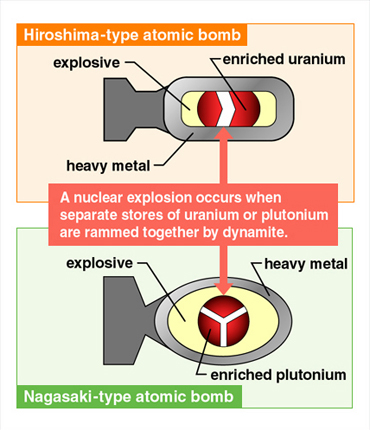 What Were the Differences Between the Atomic Bombs Dropped on Hiroshima and Nagasaki? What Were the Differences Between the Atomic Bombs Dropped on Hiroshima and Nagasaki?
 Atomic bombs employ a chain reaction of nuclear fission. In the bomb dropped on Hiroshima, uranium was used to initiate fission. Plutonium was used in the Nagasaki bomb. Atomic bombs employ a chain reaction of nuclear fission. In the bomb dropped on Hiroshima, uranium was used to initiate fission. Plutonium was used in the Nagasaki bomb.
In the atomic bomb dropped on Hiroshima, two compartments of enriched uranium-235 (235U) at near 100% purity were isolated at both ends of a thin cylinder. The detonation of high-power explosives then compressed the two parts together to initiate the fission chain reaction. The bomb, called Little Boy due to its thin shape, was 3 meters in length, 0.7 meters in diameter, and weighed 4 tons. Little Boy exploded at 600 meters above the city center. In terms of normal explosives, the bomb had a destructive force of about 16 kilotons. Gamma and neutron radiation were the types most harmful to humans, and almost all people out in the open within a 500-meter radius of the hypocenter are thought to have been killed. Damages were also caused by the heat rays and blast winds of the bomb, which took between 90 and 120 thousand lives all together.
Construction of an atomic bomb

Reference data: Shunichi Yamashita, editor, Atomic Bomb Survivors’ Affairs Division, Health and Welfare Department, Nagasaki Prefectural Government |
The atomic bomb dropped on Nagasaki employed plutonium-239 (239Pu) placed in a sphere. High-powered explosive were then detonated, instantly compressing the plutonium and triggering the fission chain reaction. Having a length of 3.5 meters, a diameter of 1.5 meters, and a weight of 4.5 tons, the bomb was squat in shape and was given the name Fat Man. This atomic bomb exploded approximately 503 meters above ground, with a force equivalent to that of about 21 kilotons of normal explosives. The bomb dropped on Nagasaki generated a more powerful blast than that used on Hiroshima and caused greater damage. The point of explosion was offset from the city center, but still resulted in 60 to 70 thousand deaths. As with the Hiroshima atomic bomb, it was mainly gamma and neutron radiation that was destructive to the human body
References:
Hoshasen Q&A (Radiation Q&A), ed. Shun’ichi Yamashita, Atomic Bomb Survivors’ Affairs Division, Health and Welfare Department, Nagasaki Prefectural Government
Nuclear: Learn, Consider, Investigate, The Japan Scientists’ Association, Godo-shuppan
Gembaku Higai Hiroshima Nagasaki (The Atomic Bombing Disasters of Hiroshima and Nagasaki), The Committee for the Compilation of Materials on the Damage by the Atomic Bombs in Hiroshima and Nagasaki, Iwanami Shoten
|

